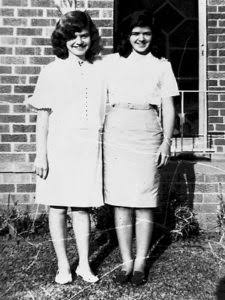Wanda Beach Murders

Wanda beach Murders

Marianne Schmidt
Marianne Schmidt had come to Melbourne from West Germany with her family in September 1958. At the time, the Schmidt family contained parents Helmut and Elizabeth and Marianne's siblings, Helmut Jr., Hans, Peter, Trixie, and Wolfgang. Another child, Norbert, was born in Australia the following year. After arriving in Australia, the Schmidts lived in a migrant hostel in Unanderra before settling in Temora. In 1963 Helmut Schmidt moved the family to Sydney after contracting Hodgkin's disease and they found a home in the suburb of Ryde. In June the next year, Helmut Schmidt died.
Marianne's next-door neighbor was Christine Sharrock.
Christine Sharrock lived with her grandparents Jim and Jeanette Taig. Her father had died in 1958 and her mother Beryl had remarried and was living in the north-western Sydney suburb of Seven Hills. Christine had moved in with her grandparents by choice and when the Schmidts came next door she developed a strong friendship with Marianne, who was the same age.

On 1 January 1965, Christine and Marianne toured the beach at Cronulla, which had been a popular picnic spot for the Schmidts. The following day the Schmidt children visited the beach there again without Christine. Elizabeth Schmidt had meanwhile been admitted to hospital for a major operation, leaving Helmut Jr and Marianne in charge of the household. On 9 January, Marianne and Christine asked Elizabeth if they could take the younger children to Cronulla the next day and were given approval; however, rain prevented the trip.
On Monday 11 January, attended by Marianne’s youngest four siblings, the girls again set off for Cronulla. They arrived at about 11 am, but it was very windy and the beach was closed. The group, therefore, walked down to the southern end of the beach and sheltered among the rocks. Eight-year-old Wolfgang Schmidt still wanted to swim, however, so Marianne went with him to a shallow part of the surf away from the rocks. After they returned to the group, they had a picnic. At some point during this time, Christine left the others and went off by herself. There is no proof of her whereabouts during this period, but after her death, it was discovered she had consumed alcohol and some food that was different from the rest of the party; it is suspected this occurred while she was alone. It was also during this time that Wolfgang noticed a boy hunting crabs. Later, he claimed to have seen the same boy twice more, once in the company of his sister and Christine and again sometime much later. There has been doubting about his description of this person, as Wolfgang variously indicated he had a homemade spear gun, a knife, or both.

When Christine returned to the group, it was decided to take a walk into the sandhills behind Wanda Beach. Around 1 pm, the group had reached a point around 400 meters beyond the Wanda Surf Club, they stopped to shelter behind a sandhill as the younger children were complaining about the conditions. Marianne told her younger siblings that she and Christine would return to the rocky area at the south end of the beach where they had hidden their bags, then return to fetch the children and head home. Rather, however, the girls continued into the sandhills. When Peter Schmidt said them they were going the wrong way, they laughed at him and walked on.
The Schmidt children stayed to wait behind the sandhill until 5 pm. They returned to collect their bags and then went home. The girls were reported missing at 8:30 pm.
The last official sighting of Marianne and Christine was by local fireman Dennis Dostine, who was walking in the region with his son and saw the girls walking about 800 yards north of the surf club. He told police that they looked like to be hurrying, and one of the girls was looking behind her as if she were being followed. Dostinex did not see anybody else.
On Tuesday, 12 January Peter Smith was taking his three young nephews for a walk through the Wanda Beach sandhills. Some distance north of the surf club, he discovered what seemed to be a department store mannequin buried in the sand. He brushed away sand from the hand and knew that it was a body. The police were called from the surf club, however, at this point, Smith thought he had found only one young woman.
When the bodies were uncovered, Marianne Schmidt was found lying on her right side with her left leg bent. Christine Sharrock was face down, her head against the sole of Schmidt's left foot. From a 34-meter long drag mark leading to the scene, police determined that Sharrock had fled, probably while Schmidt was dying, only to have been caught, killed, and dragged back to the body of her friend. Attempts had been made to rape both girls. Sharrock's skull had been fractured by a blow to the back of the head and she had been stabbed multiple times. Schmidt's throat had been slashed and she too had been stabbed many times.
A large police inquiry failed to identify the murderer. There had been various people seen in the area who were never identified; Sydney in 1965 was a conservative place and the area around Wanda Beach persuaded a range of people, who did not necessarily want to identify themselves to police. This frustrated the police investigation.

Two killings happened during early 1966 which, police at the time speculated, might have been the work of the Wanda Beach killer.
1. On 29 January 1966, a cleaning lady named Wilhelmina Kruger was murdered in the Piccadilly Arcade in Wollongong. Her body was discovered by a casual butcher when he came to work at the local butcher shop. She had been strangled & mutilated. Police thought that the murder might have been the work of the Wanda Beach killer, but would not say why.
2. On 17 February 1966, a prostitute named Anna Dowlingkoa went missing after leaving a nightclub in Kings Cross. Ten days later, her mutilated body was found by a truck driver at the side of a road in Menai. Police instantly linked her murder with that of Wilhelmina Kruger. Again, they thought that the murder might have been the work of the Wanda Beach killer, but once again, would not say what led them to believe this. The murders of Wilhelmina Kruger and Annya Dowlingkoa are far less well known now than the Wanda Beach murders.
Suspects:
Cec Johnson, a former investigator who had investigated the Wanda Beach murders, was given a painting in 1975 by Alan Bassett. Bassett had been jailed for killing Carolyn Orphan, a 19-year-old woman, in June 1966. Sent to prison for life, he served 29 years before being released in 1995.
The painting that Bassett gave Johnson showed an abstract landscape. Looking at the picture, however, Johnson became convinced that it showed a scene from the Wanda Beach murders that only the murderer would know, as well as clues to the murders of Kruger and Dowlingkoa. He became convinced that Bassett was the Wanda Beach killer.
Other detectives were far less convinced, but Johnson wrote a book about the case. Before it could be published, however, he was knocked down and killed in an accident. The book was never published. Other detectives, while retaining professional respect for Johnson, concluded that he was wrong in his belief that Bassett was the murderer.
One person he convinced, however, was crime reporter Bill Jenkins Jenkinsrepeated Johnson’s claims in his ghostwritten memoirs, As Crime Goes By, devoting a whole chapter to the Wanda Beach murders. Most of the chapter was essentially a repeat of what he’d written in his earlier book Crime Reporter, but he mentioned Johnson, Bassett, and the painting as well.
Bassett threatened legal action, but Jenkins died shortly afterward, and Bassett did not go through with his threat. Since his release, Bassett has offered to give DNA to clear his name, but whether or not he has been eliminated as a suspect by DNA has yet to be publicized.
Another suspect, not well-publicized until 1998, is Derek Percy. Percy has been arrested since 1969 for the murder of a child on a beach in Victoria. He is deemed too dangerous to be released and is the prime suspect for several other killings of children in Melbourne and Sydney.
A third suspect is Christopher Wilder. Wilder was known to police in Sydney but did not become infamous until he became a serial killer in America in the early 1980s. In the first half of 1984, he committed eight murders and attempted several more. He accidentally killed himself during a struggle with police in New Hampshire on April 13, 1984.
This case remains unsolved.

 My First News Item
My First News Item My Nine News Item
My Nine News Item